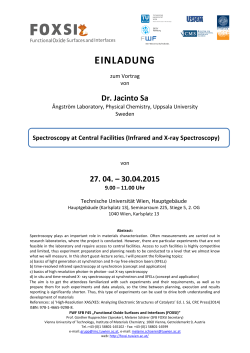
Analytical Chem 5 SOLUTIONS (AA)
Analytical Chemistry 5 Problems - SOLUTIONS A6 (Atomic Absorption Spectroscopy) 1. (a) One commonly used analytical technique is atomic absorption spectroscopy. State one use of this technique. (1) - determination of the concentration of metal ions - identification/detection of metal ions present in a sample (b) The diagram below represents the components of an atomic absorption spectrophotometer. Identify the components marked X, Y and Z and explain their function in the analysis of a sample by this technique. X – Name: monochromatic light source X – Function: produce radiation with a given wavelength that is the same as that absorbed by the metal species Y – Name: atomizer Y – Function: converts all ions in the sample into atoms Z – Name: monochromatic detector Z – Function: detects radiation of the same wavelength absorbed and converts photons to an electric signal (6) 2. Atomic absorption spectroscopy can be used to determine the concentration of lead ions in a contaminated sample of drinking water. (a) State one other use of atomic absorption spectroscopy. identification of - (1) iron in food products chromium in soil copper in blood testing purity of metal alloys mercury levels in fish (basically any NAMED metal in any NAMED sample type) (b) A calibration curve was plotted using water with known concentrations of lead ions. 100 dm3 of the contaminated drinking water was reduced by boiling, to 7.50 dm3. It was found that when the reduced volume was tested it had an absorbance of 0.55. Calculate the concentration of lead ions (in mg dm–3) in the original contaminated drinking water. (2) - from the graph: 2+ [Pb ] = 1.15 mg dm -3 (2 decimal places required given the grid) (allow between 1.13 and 1.17) - original concentration: -3 3 mass in boiled sample 1.15 mg dm x 7.50 dm = 8.63 mg 3 3 -2 concentration in 100 dm = 8.63 mg / 100 dm = 8.63 x 10 mg dm 3. -3 According to recommendations from the World Health Organization (WHO), the maximum allowed concentration of lead(II) cations, Pb2+(aq), in drinking water is 0.001 mg dm–3. The tap water taken from a building was analysed using atomic absorption (AA) spectroscopy to determine the concentration of Pb2+(aq). An AA spectrophotometer was calibrated and the following results were obtained. [Pb2+(aq)] / mg dm–3 Absorbance 0.25 0.110 0.50 0.220 0.75 0.340 1.00 0.450 1.25 0.560 Sample 0.170 Draw the calibration curve and determine whether or not the water is within the WHO recommended maximum allowed concentration of lead(II) cations. (3) - graph must show all 5 data points correctly plotted and the best fit line- sample concentration (@ A = 0.170) = 0.38 gm dm - Pb 2+ not within WHO limits -3 (allow between 0.35 and 0.42)
© Copyright 2025



















